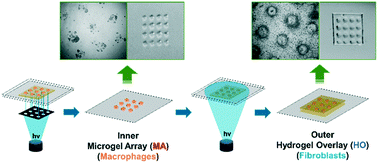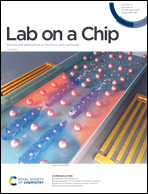Programmable multilayer printing of a mechanically-tunable 3D hydrogel co-culture system for high-throughput investigation of complex cellular behavior†
Abstract
Hydrogels are widely used as a 3D cell culture platform, as they can be tailored to provide suitable microenvironments to induce cellular phenotypes with physiological significance. Hydrogels are especially deemed attractive as a co-culture platform, in which two or more different types of cells are cultured together in close proximity, since the spatial distribution of different cell types can be rendered possible by advanced microfabrication schemes. Herein, programmable multilayer photolithography is employed to develop a 3D hydrogel-based co-culture system in an efficient and scalable manner, which consists of an inner microgel array containing one cell type covered by an outer hydrogel overlay containing another cell type. In particular, the mechanical properties of microgel array and hydrogel overlay are independently controlled in a wide range, with elastic moduli ranging from 1.7 to 31.6 kPa, allowing the high-throughput investigation of both individual hydrogel mechanics and mechanical gradients generated at their interface. Utilizing this system, phenotypical changes (i.e. proliferation, spheroid formation and Mϕ polarization) of macrophages encapsulated in microgel array, in response to complex mechanical microenvironment and co-cultured fibroblasts, are comprehensively explored.

- This article is part of the themed collection: Lab on a Chip HOT Articles 2021


 Please wait while we load your content...
Please wait while we load your content...